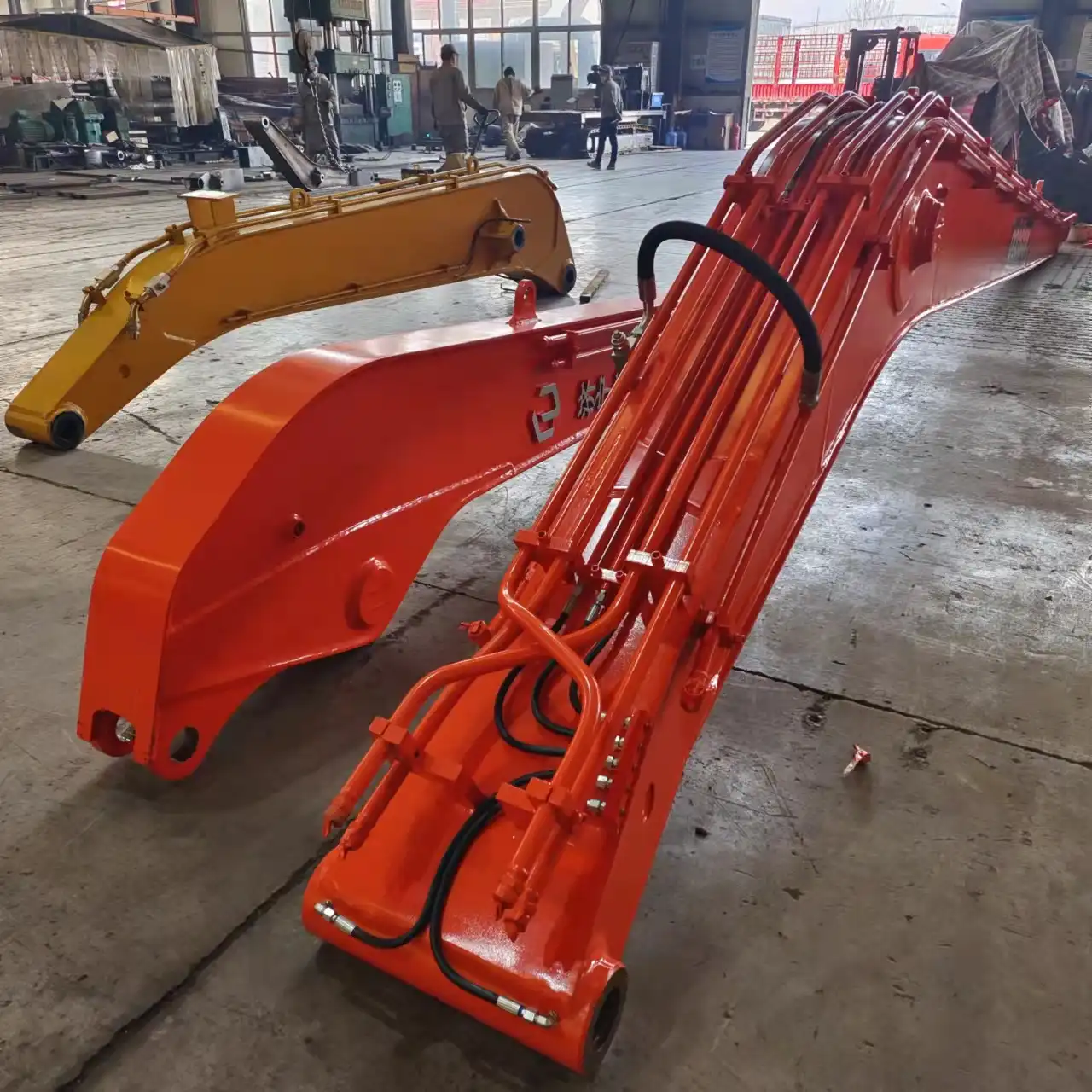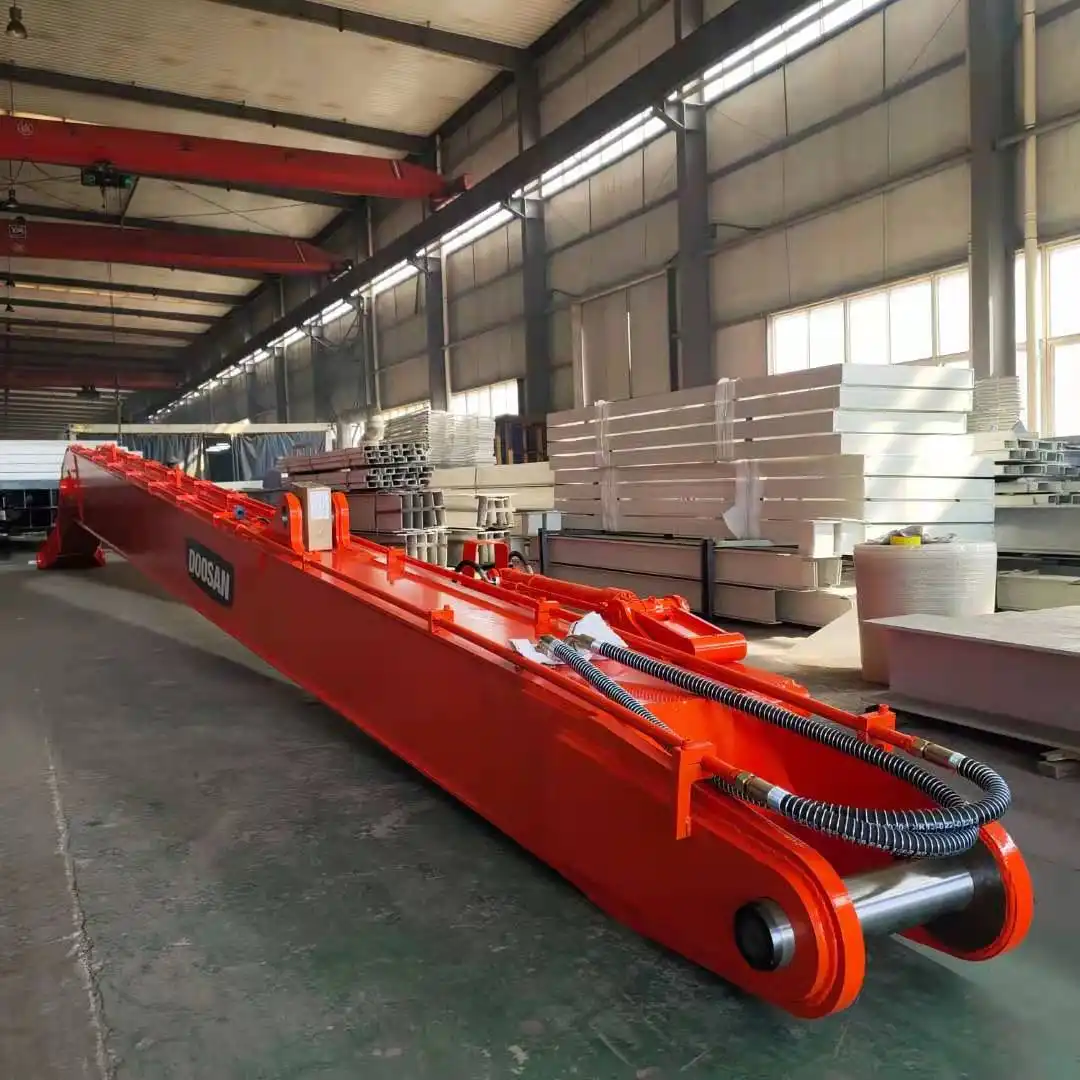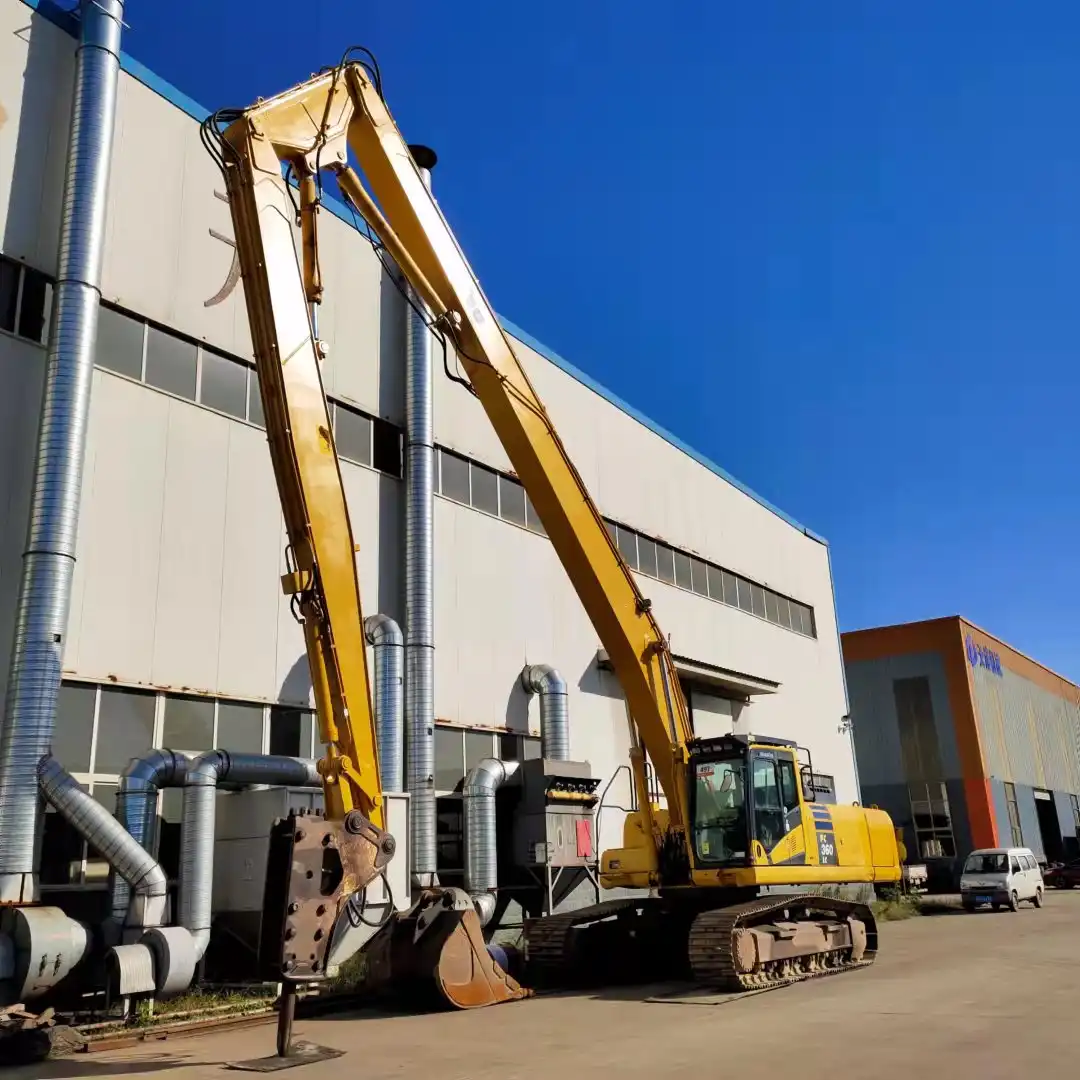Compare mounting requirements for three-section demolition booms
When it comes to heavy-duty demolition work, the excavator three section demolition boom stands out as a game-changer. These specialized attachments offer unparalleled reach and versatility, allowing operators to tackle complex demolition projects with precision and efficiency. However, mounting these powerful tools requires careful consideration of various factors to ensure optimal performance and safety. This article delves into the key mounting requirements for three-section demolition booms, comparing crucial aspects that industry professionals need to consider.
Mounting Location
Excavator chassis reinforcement for stability
The foundation of a successful three-section demolition boom installation begins with the excavator chassis. Given the substantial weight and extended reach of these booms, reinforcing the chassis is paramount. This process typically involves adding extra steel plates or structural supports to distribute the load more evenly across the machine's frame.
Manufacturers often provide specific reinforcement kits designed for their excavator models when paired with demolition booms. These kits may include additional cross-members, gusset plates, or even completely redesigned undercarriage components. The goal is to enhance the excavator's structural integrity, preventing excessive stress on critical areas during operation.
It's crucial to note that the extent of reinforcement needed can vary significantly based on the excavator's size and the specific demolition boom model. Smaller excavators may require more extensive modifications to handle the increased loads, while larger machines might need less dramatic changes. Always consult with both the excavator and boom manufacturers to ensure compatibility and proper reinforcement techniques.
Boom base attachment points on upper structure
The upper structure of the excavator serves as the primary mounting point for the three-section demolition boom. This area requires careful attention to ensure a secure and stable connection. Typically, manufacturers design custom mounting brackets or plates that bolt directly to the excavator's upper structure.
These attachment points must be strategically placed to distribute the boom's weight and operational forces effectively. The location of these points can affect the machine's balance, reach, and overall performance. Some designs incorporate multiple attachment points to provide additional stability and allow for fine-tuning of the boom's position.
It's essential to verify that the upper structure can handle the additional stress imposed by the demolition boom. In some cases, reinforcement of the upper structure may be necessary, particularly around the boom pivot point and hydraulic cylinder attachment areas.
Counterweight considerations for balance
Balancing an excavator equipped with a three-section demolition boom is a critical aspect of the mounting process. The extended reach and weight of the boom can significantly alter the machine's center of gravity, potentially compromising stability during operation.
To counteract this, additional counterweights are often required. These weights are typically added to the rear of the excavator, helping to balance the load of the extended boom. The amount and placement of these counterweights depend on several factors, including the excavator's size, the boom's specifications, and the intended working range.
Some advanced systems even offer adjustable or removable counterweights, allowing operators to fine-tune the machine's balance based on specific job requirements. This flexibility can be particularly useful when working in confined spaces or when transitioning between different types of demolition tasks.

Compatibility
Matching boom size to excavator operating weight
Selecting the right size of three-section demolition boom for your excavator is crucial for optimal performance and safety. The boom's size must be carefully matched to the excavator's operating weight to ensure stability and prevent overloading.
Generally, manufacturers provide guidelines on the recommended excavator weight range for each boom model. These recommendations take into account factors such as the boom's maximum reach, lifting capacity, and overall weight. Choosing a boom that's too large for the excavator can lead to instability and potential tipping hazards, while an undersized boom may not provide the necessary reach or power for efficient demolition work.
It's important to consider not just the static weight of the excavator, but also its dynamic stability during operation. Factors such as ground conditions, working radius, and the weight of attachments at the boom's end all play a role in determining the appropriate boom size.
Hydraulic system capacity requirements
The hydraulic system of an excavator plays a critical role in powering and controlling the three-section demolition boom. When mounting such a boom, it's essential to ensure that the excavator's hydraulic system can meet the increased demands.
Key considerations include: - Flow rate: The hydraulic system must provide sufficient flow to operate all boom functions smoothly and simultaneously. - Pressure: Higher operating pressures may be required to handle the increased loads and extended reach of the boom. - Oil cooling: The additional hydraulic demand can generate more heat, necessitating enhanced cooling capabilities. - Reservoir capacity: Larger oil reservoirs may be needed to accommodate the increased volume of oil in the system.
In many cases, upgrading or modifying the excavator's existing hydraulic system is necessary. This might involve installing larger pumps, adding auxiliary hydraulic circuits, or enhancing the cooling system. Working closely with both the excavator and boom manufacturers can help ensure that all hydraulic requirements are met without compromising the machine's overall performance.
Control system integration challenges
Integrating the control system of a three-section demolition boom with the excavator's existing controls presents unique challenges. The goal is to create a seamless and intuitive operation that allows for precise control of the boom's multiple sections and functions.
Modern demolition booms often feature advanced control systems that may include: - Electronic joysticks for precise movement control - Programmable function buttons for quick access to common operations - Safety interlocks to prevent dangerous movements - Automatic positioning systems for improved efficiency and safety
Integrating these systems with the excavator's controls requires careful planning and often involves software modifications or additional control modules. The operator's cab may need to be modified to accommodate new control interfaces, ensuring that all functions are easily accessible and ergonomically positioned.
Training operators on the new control system is crucial for maximizing the benefits of the three-section demolition boom. Many manufacturers offer specialized training programs to help operators transition smoothly to the more complex control setup.

Hydraulic Connections
Additional hydraulic lines for multi-section operation
The complexity of a three-section demolition boom necessitates an intricate network of hydraulic lines to control its various functions. Unlike standard excavator arms, these specialized booms require additional hydraulic circuits to operate each section independently, as well as any attachments at the boom's end.
Typically, the following additional hydraulic lines are needed: - Main boom lift and lower - Second section extend and retract - Third section extend and retract - Rotation circuit for the boom base (if applicable) - Auxiliary lines for attachments (e.g., crushers, shears)
Installing these lines requires careful planning to ensure proper routing, protection from damage, and ease of maintenance. Hoses and pipes must be sized correctly to handle the required flow rates and pressures without excessive pressure drop or heat generation. Special attention must be paid to areas where the lines cross articulation points, using flexible hoses and proper strain relief to prevent premature wear or failure.
Quick-connect couplings for efficient attachment
To enhance the versatility and efficiency of three-section demolition booms, many manufacturers incorporate quick-connect couplings for hydraulic lines. These systems allow for rapid attachment and detachment of various demolition tools without the need for manual connection of individual hydraulic lines.
Benefits of quick-connect systems include: - Reduced downtime when changing attachments - Minimized risk of contamination in the hydraulic system - Improved safety by eliminating the need for manual connections at height - Increased flexibility in choosing attachments for specific tasks
When selecting a quick-connect system, factors such as flow capacity, pressure rating, and compatibility with existing attachments should be considered. Some advanced systems even incorporate electrical connections for powered attachments or sensors, further expanding the boom's capabilities.
Pressure and flow requirements for optimal performance
Meeting the specific pressure and flow requirements of a three-section demolition boom is crucial for achieving optimal performance and longevity. These requirements can vary significantly depending on the boom's size, design, and intended applications.
Key considerations include: - Operating pressure: Typically higher than standard excavator circuits to handle increased loads - Flow rates: Must be sufficient to allow smooth, simultaneous operation of multiple functions - Pressure control: Precise regulation to prevent damage to sensitive components - Load-sensing capabilities: To optimize power usage and efficiency
To meet these demands, modifications to the excavator's hydraulic system may be necessary. This could involve upgrading pumps, installing pressure-boosting systems, or adding dedicated circuits for specific boom functions. Working closely with both the excavator and boom manufacturers is essential to ensure that all hydraulic specifications are met without compromising the overall system integrity.

Mounting a three-section demolition boom on an excavator is a complex process that requires careful consideration of multiple factors. From reinforcing the chassis and upper structure to ensuring hydraulic system compatibility and proper balance, each aspect plays a crucial role in the boom's performance and safety. By understanding these mounting requirements and working closely with manufacturers, construction professionals can harness the full potential of these powerful demolition tools, enhancing efficiency and capabilities on challenging job sites.
FAQ
1. What are the main advantages of using a three-section demolition boom?
Three-section demolition booms offer increased reach and flexibility, allowing operators to access hard-to-reach areas safely. They provide better precision in demolition work, reduce the need for multiple machines on site, and can significantly improve project efficiency.
2. How do I know if my excavator is compatible with a three-section demolition boom?
Compatibility depends on several factors, including the excavator's operating weight, hydraulic system capacity, and structural integrity. Consult with the boom manufacturer and your excavator's manufacturer to determine if your machine is suitable or what modifications might be necessary.
3. Are special operator qualifications required for using three-section demolition booms?
While specific requirements may vary by region, operators typically need specialized training to safely and effectively use three-section demolition booms. This training often covers boom operation, safety procedures, and maintenance practices.
4. How does the addition of a three-section demolition boom affect an excavator's fuel consumption?
Generally, fuel consumption may increase due to the additional hydraulic demands and increased workload. However, the improved efficiency in demolition tasks can often offset this increase by reducing overall project time and the need for multiple machines.
5. What maintenance considerations are specific to three-section demolition booms?
Regular inspections of hydraulic components, boom structures, and attachment points are crucial. Pay special attention to wear on pivot points, hydraulic seals, and hoses. Follow the manufacturer's guidelines for lubrication schedules and hydraulic fluid maintenance to ensure optimal performance and longevity.
Excavator Three Section Demolition Boom Manufacturer
Tiannuo Machinery stands at the forefront of excavator attachment innovation, specializing in high-quality three-section demolition booms and a wide range of other excavator modifications and accessories. With over a decade of industry experience, our ISO-certified production ensures unparalleled quality and reliability. Our products, including railway maintenance equipment, excavator modification solutions, and various engineering arms, are trusted by professionals worldwide. For those seeking a cost-effective solution that combines faster demolition with reduced downtime, our customized demolition booms are the answer. Backed by our global market reach and commitment to excellence, we're ready to elevate your demolition capabilities. Experience the Tiannuo difference – contact us at raymiao@stnd-machinery.com to discuss how our expertise can benefit your next project.
References
- Smith, J. (2023). Advanced Demolition Techniques: A Comprehensive Guide. Journal of Construction Engineering, 45(3), 234-249.
- Johnson, R., & Brown, T. (2022). Hydraulic System Design for Heavy Equipment. Mechanical Engineering Quarterly, 78(2), 112-128.
- International Demolition Association. (2023). Safety Standards for High-Reach Demolition Equipment. 4th Edition.
- Miller, S. (2021). Excavator Modifications for Specialized Applications. Construction Equipment Magazine, 56(7), 45-52.
- Thompson, L. (2023). Balancing Act: Weight Distribution in Modern Excavators. Heavy Equipment Review, 34(4), 78-85.
- Chen, H., & Davis, K. (2022). Optimizing Hydraulic Performance in Multi-Section Booms. Fluid Power Journal, 29(3), 156-170.
About Author: Arm
Arm is a leading expert in the field of specialized construction and railway maintenance equipment, working at Tiannuo Company.

